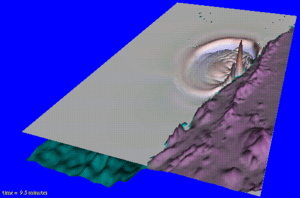1998 Papua New Guinea earthquake facts for kids
| UTC time | 1998-07-17 08:49:13 |
|---|---|
| ISC event | 1167076 |
| USGS-ANSS | ComCat |
| Local date | July 17, 1998 |
| Local time | 6:49 pm |
| Duration | 19 seconds |
| Magnitude | 7.0 Mw |
| Depth | 30 km (19 mi) |
| Epicenter | 3°07′S 142°26′E / 3.11°S 142.44°E |
| Type | Dip-slip |
| Areas affected | Papua New Guinea |
| Max. intensity | VIII (Severe) |
| Tsunami | 15 m (49 ft) |
| Casualties | 2,183–2,700 dead Thousands injured |
The 1998 Papua New Guinea earthquake was a powerful natural event that happened on July 17, 1998. It had a strength of 7.0 on the moment magnitude scale. This earthquake struck near the northern coast of Papua New Guinea, close to a town called Aitape.
The earthquake caused a huge landslide under the sea. This landslide then created a very large tsunami wave. The tsunami crashed into the coast, sadly killing between 2,183 and 2,700 people. Thousands more were injured.
What Caused the Earthquake?
The earthquake happened at 6:49 PM local time. It occurred where two giant pieces of the Earth's crust meet. These pieces are called tectonic plates. In this area, the Australian Plate and the Pacific Plate push against each other.
Scientists first thought the tsunami was caused by the Pacific Plate dropping about 2 meters. This drop was thought to be along a fault line about 25 miles long. However, later studies showed that a massive underwater landslide was the main cause.
This event taught scientists something important. Even smaller earthquakes can cause huge tsunamis if they trigger landslides underwater. These tsunamis can be very dangerous. This is because the earthquake might be too small for people on land to feel. It might also not be detected by warning centers. This means a tsunami could appear without any warning.
How the Earthquake Affected People
The main earthquake shock and smaller aftershocks were felt in many towns. These towns were located around where the earthquake started. The main shock caused some minor damage to a 62-year-old church. This church was at the Sissano Mission.
The shaking was so strong that many people left their homes. This happened in villages like Malol, Arop, and Warapu. The ground also cracked open in Arop and Warapu.
A few minutes after the earthquake, many people heard a loud clap. This sound came as the tsunami waves reached the shore. The tsunami caused a lot of destruction. At least 2,200 people died, and thousands were hurt. About 9,500 people lost their homes, and around 500 went missing.
The highest waves were about 15 meters (49 feet) tall. The average wave height was about 10.5 meters (34 feet).
The worst-hit area was a 30-kilometer (19-mile) strip of coast. This strip ran northwest from Aitape to the village of Sissano. Many villages in the tsunami's path were completely destroyed. Others were badly damaged.
The tsunami waves pulled entire buildings from their foundations. They carried these buildings 50 to 60 meters (164 to 197 feet) away. The village of Arop was located on a narrow piece of land. It was between the coast and the Sissano Lagoon. Arop was directly in the tsunami's path and was hit the hardest.
See also
 In Spanish: Terremoto de Aitape para niños
In Spanish: Terremoto de Aitape para niños



